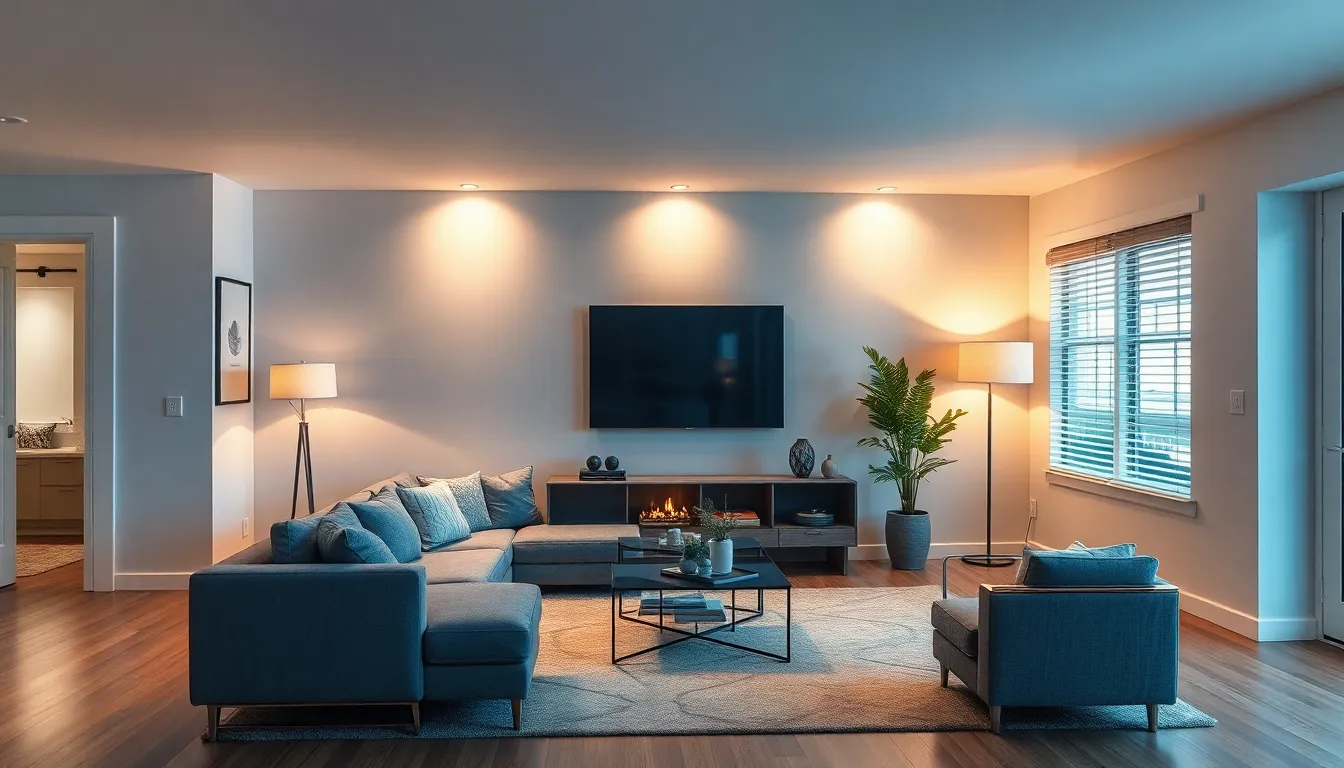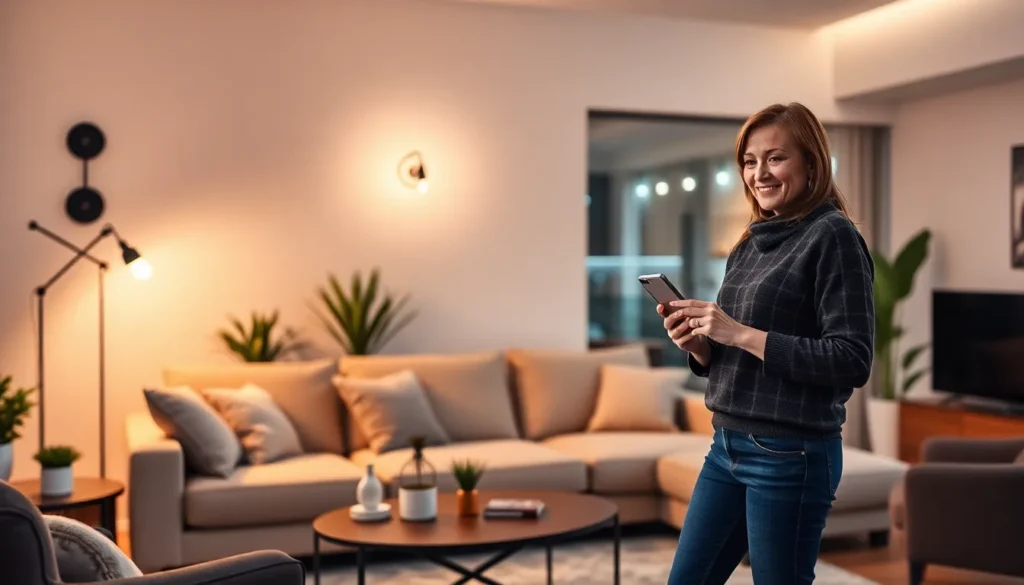Table of Contents
ToggleIn today’s tech-driven world, smart lighting solutions are transforming how people illuminate their spaces. These innovative systems not only enhance ambiance but also offer energy efficiency and convenience. Homeowners and businesses alike are discovering the benefits of integrating smart lighting, which can be controlled remotely and customized to fit individual needs.
Imagine being able to adjust the brightness or color of your lights with just a tap on your smartphone. With smart lighting, this is a reality. From automated schedules to voice-activated controls, these solutions provide unmatched flexibility and comfort. As the demand for smart home technology grows, understanding the various options available in smart lighting becomes essential for anyone looking to upgrade their environment.
Overview of Smart Lighting Solutions
Smart lighting solutions represent a significant advancement in lighting technology, combining functionality with innovation. These systems include smart bulbs, smart switches, and lighting controls, which offer tailored lighting experiences for various environments.
Key Features of Smart Lighting Solutions
- Remote Control: Users can manage lights from smartphones or tablets, allowing adjustments from anywhere.
- Voice Activation: Integration with virtual assistants facilitates voice commands, streamlining lighting control.
- Automated Scheduling: Set routines to turn lights on or off based on personal schedules.
- Energy Efficiency: Smart lighting often utilizes LED technology, reducing energy consumption and costs by up to 75%.
- Adaptive Lighting: Systems adjust light intensity and color based on the time of day or user preference.
Types of Smart Lighting Solutions
- Smart Bulbs: Replace traditional bulbs with connected alternatives, offering customization in brightness and color.
- Smart Switches: Replace standard switches, providing control over multiple lights in a single fixture.
- Smart Fixtures: Integrated lighting solutions that combine aesthetic design with smart technology.
- Outdoor Smart Lighting: Designed for exterior use, these systems enhance security and curb appeal.
Advantages of Implementing Smart Lighting
- Enhanced Security: Automated lights provide the appearance of occupancy, deterring potential intruders.
- Increased Convenience: Users can adjust lighting without physical interaction, adding comfort and ease.
- Custom Ambiance: Personalized settings create the desired mood for gatherings or relaxation.
Considerations for Smart Lighting Solutions
- Compatibility: Ensure devices are compatible with existing home automation systems.
- Installation: Opt for straightforward setups or professional assistance depending on complexity.
- Cost: Evaluate long-term savings against initial investment, often recouped through reduced energy bills.
Benefits of Smart Lighting Solutions

Smart lighting solutions offer numerous advantages that enhance both residential and commercial environments. These benefits include energy efficiency, convenience, automation, and enhanced security.
Energy Efficiency
Energy efficiency stands as a primary benefit of smart lighting solutions. LED technology decreases energy consumption significantly, often by up to 80% compared to traditional incandescent bulbs. Automated scheduling allows lights to operate only when necessary, reducing waste. Integration with smart home systems enables real-time energy monitoring, providing users with insights into their usage patterns. These factors contribute to lower utility bills and a smaller carbon footprint.
Convenience and Automation
Convenience and automation define smart lighting solutions’ appeal. Users can control lighting remotely through smartphones or tablets, adjusting settings from anywhere. Voice activation through virtual assistants simplifies operations, allowing users to issue commands hands-free. Scheduling capabilities enable automatic adjustments based on time or user behavior, ensuring optimal lighting at all times. These features enhance everyday convenience and streamline household routines.
Enhanced Security
Enhanced security is another significant benefit of smart lighting solutions. Users can simulate presence by programming lights to turn on and off at random intervals, deterring potential intruders. Motion-sensing lights provide illumination in key areas, enhancing visibility and safety. Additionally, remote access enables users to monitor and control lighting while away from home, adding a layer of security and peace of mind.
Types of Smart Lighting Solutions
Smart lighting solutions include various technologies that enhance both aesthetics and functionality in a space. Understanding their specific types helps users choose the best option for their needs.
Smart Bulbs
Smart bulbs are versatile lighting options with built-in connectivity features. These LED bulbs allow users to control brightness and color temperature via smartphones or voice commands. Many smart bulbs support automation, enabling users to create schedules or sync lighting with daily activities. Examples include Philips Hue and LIFX, which offer millions of color options and easy integration with smart home systems.
Smart Switches
Smart switches replace traditional light switches, providing users with control over their existing lighting fixtures. These devices connect to Wi-Fi or Bluetooth, allowing remote operation through apps or voice commands. Smart switches often include features such as scheduling and energy monitoring. Notable brands include Wemo and Lutron, which ensure compatibility with various bulb types and enhance energy-saving efforts.
Smart Fixtures
Smart fixtures combine traditional lighting fixtures with advanced technology, offering built-in smart features. These include recessed lighting, chandeliers, and outdoor lights equipped with smart capabilities. Users can control brightness, color, and schedules through smartphones or voice assistants. Brands like Ring and Philips Hue provide smart fixture options that enhance both convenience and security through features like motion detection and alert systems.
Key Features to Consider
Smart lighting solutions come with several key features that enhance their effectiveness and user experience. Understanding these features aids in selecting the best options for individual needs.
Compatibility with Other Smart Devices
Compatibility with other smart devices ensures seamless integration within a smart home ecosystem. This compatibility typically involves connectivity with platforms like Google Home, Amazon Alexa, and Apple HomeKit. Many smart lighting products support protocols such as Zigbee or Z-Wave, allowing them to work alongside various smart devices, including thermostats, security cameras, and sensors. Ensuring compatibility can simplify control and create a more cohesive smart home experience.
App Control and User Interface
App control and user interface quality significantly influence user satisfaction. Many smart lighting solutions offer dedicated mobile apps that provide intuitive controls and easy navigation. Users can adjust brightness levels, change colors, and set schedules directly from their smartphones. Some apps also support voice commands and incorporation of routines, allowing for enhanced automation. A well-designed app interface contributes to a more effortless and enjoyable user experience.
Customization Options
Customization options provide flexibility for users to create personalized lighting experiences. Smart lighting solutions often allow adjustments in color temperature, brightness levels, and even light schedules based on user preferences. Many systems offer various pre-set scenarios—such as “movie night” or “reading mode”—to evoke specific moods. Further customization can include programmable scenes that align with daily activities or seasonal changes. This level of personalization enhances comfort and adaptability in any space.
Smart lighting solutions are transforming how people experience and interact with their environments. By offering enhanced convenience energy efficiency and customizable options these technologies cater to diverse needs. As smart home technology continues to evolve embracing these advancements can significantly improve both comfort and security.
Investing in smart lighting not only elevates ambiance but also contributes to long-term savings through reduced energy consumption. With a variety of products available users can easily find solutions that fit their lifestyles and preferences. Adopting smart lighting is a step toward a more connected and efficient home or business.







